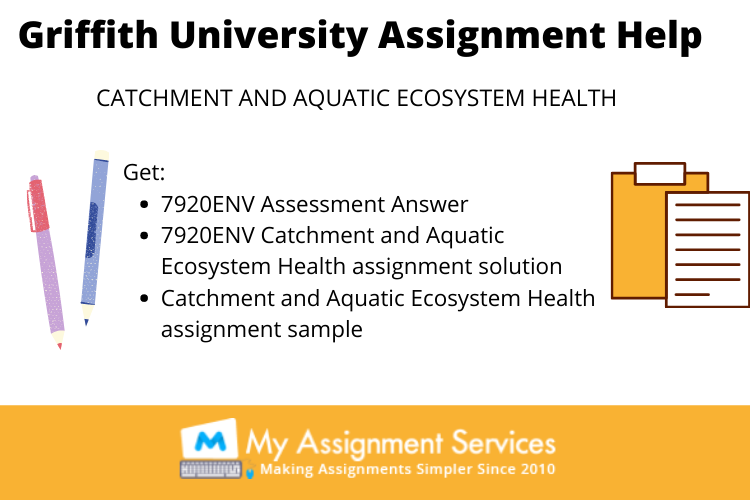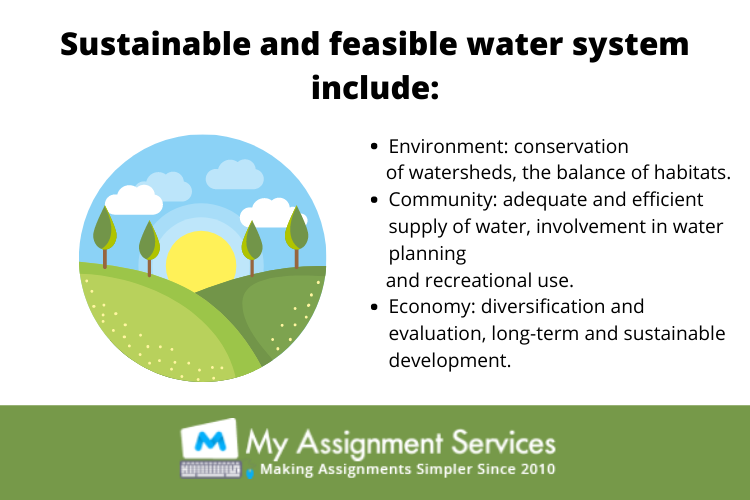The academic program on Catchment and Aquatic Ecosystem Health gives students an in-depth understanding of the problems and challenges associated with sustainable aquatic ecosystem management. Our Catchment and Aquatic Ecosystem Health assignment help will help you to get reliable and efficient assignments. Aquatic ecosystem health research is a relatively new area in which biophysical understandings of how natural systems operate with social objectives, and human values are brought together. Satisfying the rising demands for water without degrading marine environments and the ecological products and services they provide is a major challenge for society. The emphasis of the course will be on three main components:
(1)Understanding hydrological regimes and the methods of environmental flows, including the basic concepts of aquatic ecosystem hydrology and the architecture of environmental flow regimes;
2)The theory and methodology behind the evaluation of the health of aquatic environments, including the creation and validation of cost-effective river health ecological assessment techniques;
3)Principles and practical instruments for the implementation of riparian restoration projects across a wide variety of aquatic ecosystems.
Throughout the semester, a parallel Integrated Water Management project will build skills that complement the content provided in the co-requisite course 1 (WATR7300) and the co-electives offered in semester 2 - WATR7400, WATR7600, WATR7700, WATR7900, and WATR7200 or WATR7800 in the summer semester.

We understand the difficulties and challenges that students face dealing with catchment and aquatic ecosystem health assignment which is why My Assignment Services brings for them the most reliable 7920ENV Assessment Answer with our Catchment and Aquatic Ecosystem Health assignment help. We work with a team of2250+ PhD scholars and 1350+ different subject matter expertswho are competent and dedicated writers working in the field of writing service. They adhere to thegrading rubric, referencing guidelines, in-text and end-text citation. We provide 7920ENV Catchment and Aquatic Ecosystem Health assignment solution based on the material gathered from authentic and original sources. We ensure efficient content quality, which is 100% plagiarism-free
Online Assignment Help
Custom Essay Help
Dissertation Writing Guidance
Aquatic Ecosystems Environmental Functions
Numerous important environmental functions are carried out by aquatic ecosystems. They reduce flooding, recharge groundwater, recycle nutrients, increase and conserve stream flow, purify water and provide people with wildlife and recreation wildlife. In many parts of the United States, rapid population growth, followed by increased agricultural, commercial, and residential production, have resulted in insecticides, toxic landfills leaches, fertilizers, feedlot waste polluting surface water, and motor oil. The use of water has also increased as water pollution and releases of nutrient-laden urban sewage waste have increased, thus decreasing flows available for waste dilution. Increased availability of sediment from urban development, forestry and agriculture, has also resulted in increased turbidity and sedimentation in downstream canals, reservoirs and dams, with associated losses of fish and wildlife habitat quantity and quality, recreational and scenic values and water storage and transportation capacity.
Our Catchment and Aquatic Ecosystem Health assignment help experts say that channelization has accommodated increased demands for irrigation of wetlands, resulting in more depletion of stream habitat. This has contributed to growing numbers of marine species being extinct or imperilled and to the deficiency of many beneficial uses of water, including fishing, drinking and swimming. While private and public aquatic ecosystem management decisions have built hydroelectric power supplies, improved water transport, reduced flood hazards and supplied water for agricultural, industrial and urban purposes, these activities have also altered the chemical, biological and physical processes of aquatic ecosystems.
Naturally, aquatic ecosystem restoration can be achieved in phases, and specific ecosystem features and functions, such as potable water, can be restored even though other ecosystem features deviate from natural conditions. Thus, partial ecological restoration can be the organizational management target in some circumstances and can provide substantial ecological benefits even if complete restoration is not achieved. Therefore, since the loss and impairment of aquatic ecosystems are followed by the loss and impairment of valuable human-important environmental functions and facilities, and since aquatic ecosystem restoration is feasible, the Committee concludes that a large-scale programme for the restoration of aquatic ecosystems in the United States should be introduced in order to restore and protect the physical, biological, and groundwater and its biological integrity. The purpose of such a programme is to:
• Appropriate non-point source contamination issues;
• Arrest the decrease in populations of wildlife; and
• Restore all kinds of wildlife ecosystems with a preference for the habitat of endangered species.
Failure to promptly restore aquatic habitats would result in dramatically increased environmental costs, species or ecosystem types’ destruction, and irreversible ecological damage later on.
We have provided Griffith University assignment help to many students. They were satisfied with the content received, which helped them in attain higher grades and were praised by their professors. We have Catchment and Aquatic Ecosystem Health assignment sample on our website; therefore, the students can check the content quality and have an idea about our working style.
RESTORATION OF AQUATIC ECOSYSTEMS
The destruction of freshwater habitats by the number of stressors has increased logarithmically is because of multiple anthropogenic activities to meet the requirements of increasing populations. As a result, certain drastic corrective/restoration steps are required for many aquatic habitats. Restoration is the ‘return of an ecosystem prior to disturbance to a near approximation of its state’ or the re-establishment of aquatic functions and associated chemical, biological and physical characteristics pre-disturbance. It is a comprehensive method that is not accomplished by the discrete manipulation of individual components.
The aim is to imitate a natural, ecologically integrated self-regulating mechanism with the landscape in which it happens. Sometimes, one or more of the following processes are needed for restoration: biological manipulation; reconstruction of preceding physical conditions; including the reintroduction of native fauna and flora that are absent and chemical adjustment of soil and water.
These concepts concentrate on technological and scientific concerns, but the importance of community values and views should be considered, as with all environmental protection activities. Coordination with the organizations and local residents who could be impacted by the project will help create the support required to move the project forward and assure that the restored area is preserved in the long term. In addition, cooperation with all stakeholders may also include valuable tools, ranging from technological skills and finance to voluntary implementation assistance and monitoring assistance. Principles for restoration are:
Aquatic resources are preserved and protected:
Existing, relatively intact ecosystems are the key to the conservation of biodiversity and include the biota and other natural materials required to restore impaired systems.
Ecological integrity restoration:
Ecological integrity applies, in particular, to the condition of the structure, the ecosystem, natural processes and composition of its biotic organisms, and to the physical environment.
Restore natural structure:
Most aquatic resources in need of restore have issues that have resulted from destructive changes in the shape of the channel or other physical features, which in turn may have contributed to the issues such as deterioration of the environment, changes in siltation and flow regimes
Natural structure restoration:
Most aquatic resources in need of repair have trouble that has resulted from disruptive changes in the form of the channel or other physical characteristics that could, in turn, have led to issues such as changes in flow regimes, environmental degradation and siltation.
Work within broader landscape context and the watershed:
Restoration needs a structure and planning associated with the whole watershed, not just the portion of the water body's most degraded site. The restored aquatic resources can be adversely affected by activities in the watershed.

Set clear, attainable and measurable targets:
Exact objective implementation and providing the criteria for evaluating progress. The objective chosen should be environmentally feasible, taking into account the region's natural potential, and socio-economically, taking into account the resources available and the scope of public support for the restoration project.
Predict future changes:
Since the environment, nature and our customs are both energetic, many expected environmental friendly and social changes should be taken into account in the restoration design.
Require the skills and experiences of an interdisciplinary team:
Private business, government departments and universities. It possibly provides useful and effective information and expertise to help assure recovery efforts are focused on well-balanced and detailed plans.
Self-sustainability plan:
Make sure the long-term stability of a restored area by minimising the need for in progress or developing site maintenance. In addition to diminishing the requirement for maintenance, designing and preparing for self-sustainability also means fostering environmental probity, as an ecosystem in better shape has the capability of changing.
Use passive restoration when necessary: merely growing or terminating the causes of deterioration and providing recuperation time for the site to naturally revive. Passive restoration will re-establish firm floodplains and channels for some rivers and streams, re-cultivate riparian vegetation, and boost in-stream domain in the absence of a formal restoration project. Passive restoration is highly dependent on natural transformation and processes, and it is therefore important to evaluate the site's recovery requirements and decide if time and natural processes and growth will meet them.
FAQs Answered By Our Catchment and Aquatic Ecosystem Health Assignment help Experts
-
What is Restore indigenous species and stop non-indigenous species?
Restore native species and stop non-native species: Since they are professional colonizers of contaminated areas and inadequate natural controls, native species are outcompeted by many invasive species.
-
Define where possible, natural fixes and bioengineering techniques?
Bioengineering is a construction method involving the combination of living plants and inorganic materials or dead plants, the development of living, erosion prevention systems, the management of sediments and other contaminants and the provision of habitat. For bank stabilization and erosion control, water treatment and flood prevention, such techniques would be effective.
These concepts concentrate on scientific and technological concerns, but the relevance of community views and values cannot be ignored, as with all environmental protection activities. The distinction between good outcomes and failure may be the existence or lack of public support for any restoration project. Coordination with individuals and firms who may be impacted by the project will help create the support required to move the project forward and ensure the long-term preservation of the reinstated area (Ramachandra, T.V. et al., 2002). A sustainable and feasible water system, therefore, including problems such as:
•Environment:conservation of watersheds, the balance of habitats, bio-solids and wastewater.
• Community:adequate and efficient supply of water, involvement in water planning and recreational use.
• Economy:diversification and evaluation, long-term and sustainable development.
We cover each and every area concerning catchment and aquatic ecosystems within our
7920ENV Assessment Answer. Apart from providing you full-time assistance and written assignments, our experts help the students with selective sections any particular topic with our
Catchment and Aquatic Ecosystem Health assignment help.
So what are you waiting for? Opt for our Griffith University assignment help.
Features That Makes Us Better Catchment and Aquatic Ecosystem Health Assignment Help Than The Rest
We have been working in the field for over a decade. Our working efficiency and experience is what makes our Catchment and Aquatic Ecosystem Health assignment help better than the rest. Apart from providing you with the best and dependable 7920ENV Catchment and Aquatic Ecosystem Health assignment solution, you get to avail the following features:
Affordable prices
24x7 online presence
Full-time student support
Live tracking system
In-depth research
Arguments supported by high-quality evidence
Proper citation and reference for the sources used
Catchment and Aquatic Ecosystem Health assignment sample
100% plagiarism-free content
Proofreading, editing by professionals
Frequent discounts
Easy refund policy
Before deadline delivery
Avail of our Catchment and Aquatic Ecosystem Health assignment help and attain top grades. Fill the form now!
24 X 7 Support
100+ Subjects Covered
2000+ Ph.D Experts
Get It Done! Today
1,212,718Orders
4.9/5Rating
5,063Experts
Highlights
- 21 Step Quality Check
- 2000+ Ph.D Experts
- Live Expert Sessions
- Dedicated App
- Earn while you Learn with us
- Confidentiality Agreement
- Money Back Guarantee
- Customer Feedback
Just Pay for your Assignment
Turnitin Report
$10.00Proofreading and Editing
$9.00Per PageConsultation with Expert
$35.00Per HourLive Session 1-on-1
$40.00Per 30 min.Quality Check
$25.00Total
Free- Let's Start







